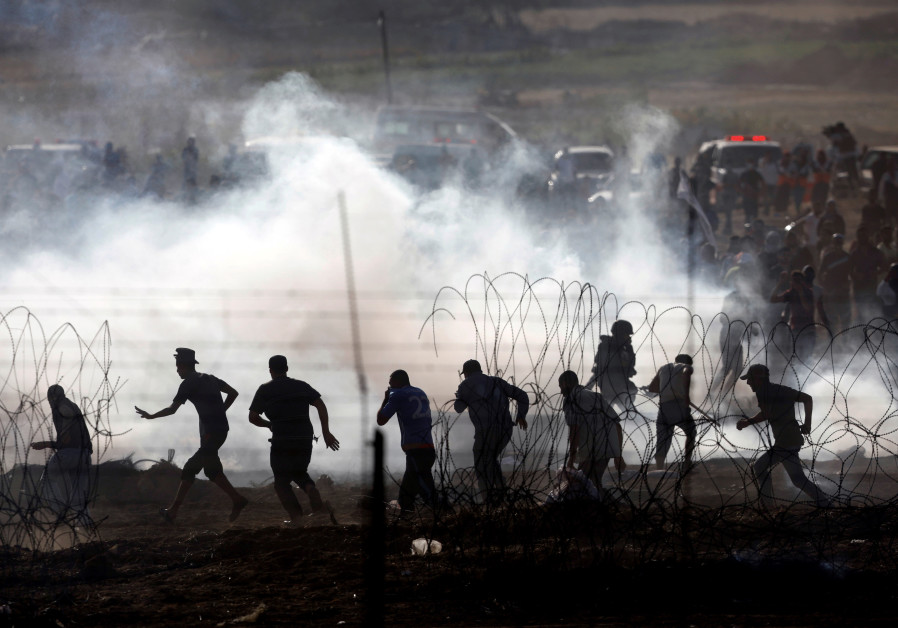Analysis: IDF, Hamas one miscalculation away from another Gaza war

Palestinians protesting on the Gaza side of the border between Israel and Gaza, June 2018. (photo credit: AMIR COHEN/REUTERS)
As the summer comes to a close, the chances of war in the Gaza Strip between Israel and Hamas have risen once again.
On Thursday morning, IDF Chief of Staff Lt.-Gen. Gadi Eisenkot decided to reinforce troops along the tense security fence, citing the military’s policy of preventing infiltration from the blockaded coastal enclave into southern Israel.
The reinforcements will include snipers as well as infantry and armored forces. The IDF has also deployed the Iron Dome missile defense system over fears of mortar and rocket fire from the blockaded coastal enclave.
The decision was made ahead of the 29th week of violent Friday protests out of concern over a possible escalation. The protests which began at the end of March and which call on Israel to lift the blockade have claimed the lives of close to 200 Palestinians.
Six months in, the weekly protests have become even more violent.
The internal dynamics in the Strip, especially the humanitarian situation that continues to inch closer to its boiling point, have stoked the flames. In addition to the United States cutting all funds for UNRWA, unemployment is above 40 percent, hospitals are running out of fuel and supplies and residents have only six hours of electricity.
On Wednesday, The Telegraph reported that Hamas leader Yayha Sinwar said that the group was seeking a long-term truce with Israel. In return for the lifting of the blockade, he said, the group and other Palestinian factions would ensure that all rocket fire and other attacks from Gaza would stop.
According to Israel’s military, more than 430 mortars and rockets have struck Israeli territory in the past year, a significant increase from the 31 which fell in Israel the previous year and 15 which struck Israel in 2016.
According to the report, Sinwar was “confident” that a deal could be reached by mid-October; but if not, Hamas would “cause chaos” along the border with Israel.
Egypt has been mediating between Israel and Hamas over the past few months. On Thursday, German Chancellor Angela Merkel said that Germany is “making efforts” to advance a long-term ceasefire arrangement between Israel and Gaza, without elaborating on what she meant.
In addition to the Gazan side of the issue, Defense Minister Avigdor Liberman and Education Minister Naftali Bennett have clashed, with Bennett accusing Liberman of a “weak and lefist” policy vis-a-vis Hamas and Liberman accusing Bennett of choosing to destroy the right-wing government and starting his election campaign early.
Over the past few weeks, the protests along the border fence have increased in intensity and Gazans have been hurling improvised explosive devices such as firecrackers and grenades at IDF forces. Over 100 explosive devices were thrown at troops last Friday alone.
Dozens of Gazans have managed to infiltrate into Israeli territory, cutting through the fence with bolt cutters to damage heavy equipment used by Israel’s defense establishment to build the underground barrier. Other successful infiltrations have seen Gazans damaging IDF posts.
While none of the infiltrations have led to any Israeli injuries or fatalities, an IDF soldier was killed by a Gazan sniper and several other troops have been injured.
Thousands of Palestinians have also begun to gather at different spots along the security fence every night, rioting until midnight. Incendiary balloons and kites are also still being launched into southern Israel, burning over 7,000 acres of fields and nature reserves.
In July, following a flare-up of violence which saw Hamas launch 200 mortars and rockets into southern Israel and the IDF striking over 40 Hamas targets across the Gaza Strip, Israel was reported to have given Hamas via Egyptian intermediaries an ultimatum to stop the incendiary aerial devices. If not, Israel said it would have no other choice but to launch a military offensive.
But three months later they keep flying in, some even landing in schoolyards and others carrying explosive devices. Yet Israel hasn’t launched an offensive.
Nevertheless, both Gazans and Israelis are concerned that the situation is eerily similar to the last conflict, Operation Protective Edge in 2014.
One small miscalculation could lead to another deadly war. Only this time it won’t be during the summer.
Join Jerusalem Post Premium Plus now for just $5 and upgrade your experience with an ads-free website and exclusive content. Click here>>






Comments are closed.